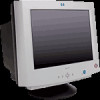HP CRT Monitor p930 hp P930 19'' crt P9009w, user's guide - Page 43
Cadmium, Mercury, the electrical or electronics components associated with
 |
View all HP CRT Monitor p930 manuals
Add to My Manuals
Save this manual to your list of manuals |
Page 43 highlights
TCO '99 Requirements The relevant TCO'99 demand requires that plastic components weighing more than 25 grams must not contain flame retardants with organically bound bromine or chlorine. Flame retardants are allowed in the printed circuit boards since no substitutes are available. ✎ Bioaccumulative is defined as substances which accumulate within living organisms. Cadmium Cadmium is present in rechargeable batteries and in the colour-generating layers of certain computer displays. Cadmium damages the nervous system and is toxic in high doses. The relevant TCO'99 requirement states that batteries, the colour-generating layers of display screens and the electrical or electronics components must not contain any cadmium. ✎ Cadmium is a heavy metal that is Bioaccumulative. Mercury Mercury is sometimes found in batteries, relays and switches. It damages the nervous system and is toxic in high doses. The relevant TCO'99 requirement states that batteries may not contain any mercury. It also demands that mercury is not present in any of the electrical or electronics components associated with the labelled unit. There is however one exception. Mercury is, for the time being, permitted in the back light system of flat panel monitors as there today is no commercially available alternative. TCO aims on removing this exception when a mercury free alternative is available. ✎Mercury is a heavy metal that is Bioaccumulative. D-4 User's Guide











